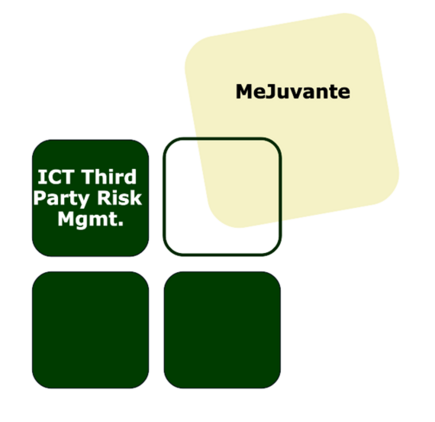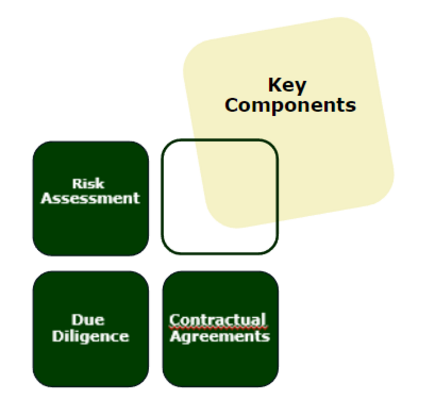Mastering ICT Third-Party Risk (2/6)
1. 1. Introduction to ICT Third Party Risk Management
In today's interconnected and technology-driven world, businesses heavily rely on third-party service providers to support their information and communication technology (ICT) infrastructure. While these partnerships bring numerous benefits, they also expose organizations to various risks. This is where ICT Third Party Risk Management plays a crucial role.
ICT Third Party Risk Management refers to the process of identifying, assessing, and mitigating the potential risks that arise from engaging with third-party vendors for ICT services. By effectively managing these risks, organizations can protect their valuable data, maintain operational resilience, and ensure regulatory compliance.

2. Understanding the Importance of ICT Third Party Risk Management
The importance of ICT Third Party Risk Management cannot be overstated. With the increasing complexity of technology ecosystems and the growing number of cyber threats, organizations must be proactive in identifying and addressing potential risks. Failure to do so can result in severe consequences, including financial loss, reputational damage, and legal liabilities.
By implementing a robust ICT Third Party Risk Management framework, organizations can identify vulnerabilities and establish controls to mitigate these risks. This ensures that the organization's critical assets and sensitive data are adequately protected, reducing the likelihood of security breaches and data leaks. Moreover, effective risk management enables organizations to maintain trust with their customers, partners, and stakeholders, thereby safeguarding their reputation in the market.
3. Key Components of ICT Third Party Risk Management
To effectively manage third-party risks in the ICT domain, organizations need to consider several key components. These components work in tandem to create a comprehensive risk management framework that addresses the unique challenges of the digital landscape.
3.1 Risk Assessment
ICT Third Party Risk Management comprises several key elements that are essential for its effective implementation. These elements include risk assessment, due diligence, contractual agreements, ongoing monitoring, and incident response.
Risk assessment is the foundation of ICT Third Party Risk Management. It involves identifying and evaluating the risks associated with third-party relationships, taking into account factors such as the criticality of the service provided, the sensitivity of the data involved, and the potential impact of a disruption. Risk assessments enable businesses to prioritize their risk mitigation efforts and allocate resources according

3.2 Due Diligence
Before engaging with a third-party vendor, organizations must perform due diligence to assess their capabilities, reliability, and security posture. This includes evaluating the vendor's financial stability, reviewing their track record, and conducting security audits. By conducting due diligence, organizations can ensure that they are partnering with trustworthy and competent vendors.
3.3 Contractual Agreements
Establishing comprehensive contractual agreements is vital for managing third-party risks. These agreements should clearly define the roles and responsibilities of both parties, specify the security requirements, and outline the consequences for non-compliance. Additionally, organizations should include provisions for regular audits and assessments to ensure ongoing compliance.
4. The Role of Governance in ICT Third Party Risk Management
Governance plays a crucial role in ICT Third Party Risk Management. It provides the framework and structure necessary for effective risk management practices. A robust governance framework includes the following elements:
4.1 Contractual Agreements
Organizations should develop clear policies and procedures that define the expectations and guidelines for managing third-party risks. These policies should cover areas such as vendor selection, risk assessment methodology, contract negotiations, and ongoing monitoring.
4.2 Risk Appetite and Tolerance
Organizations must establish their risk appetite and tolerance levels for engaging with third-party vendors. This involves defining the acceptable level of risk the organization is willing to take and setting thresholds for specific risk factors. By aligning risk appetite with business objectives, organizations can make informed decisions regarding third-party engagements.
4.3 Accountability and Oversight
Accountability and oversight are critical for ensuring that the ICT Third Party Risk Management process is effectively implemented. Organizations should designate individuals or teams responsible for overseeing vendor relationships, monitoring compliance, and conducting regular risk assessments. This ensures that the risk management process is transparent and consistently applied throughout the organization.
5. Assessing and Managing Third Party Risks in ICT
Assessing and managing third-party risks in the ICT domain requires a systematic approach. The following steps can help organizations effectively identify, assess, and mitigate these risks:

5.1 Inventory and Categorization
Organizations should maintain an inventory of all third-party vendors and categorize them based on the level of risk they pose. This allows organizations to prioritize their risk management efforts and allocate resources accordingly.
5.2 Risk Identification and Assessment
Once the inventory is established, organizations should conduct a comprehensive risk assessment for each vendor. This involves identifying potential risks, evaluating their likelihood and impact, and assigning a risk rating. By quantifying risks, organizations can prioritize mitigation efforts and allocate resources effectively.
5.3 Risk Mitigation and Monitoring
After identifying and assessing risks, organizations should develop and implement mitigation strategies. These strategies may include implementing additional security controls, establishing incident response plans, and conducting regular audits. Organizations should also continuously monitor third-party relationships to identify any emerging risks and take appropriate actions.
6. Key Considerations for Selecting Third-Party Vendors in ICT
Selecting the right third-party vendors is a critical aspect of ICT Third Party Risk Management. Organizations should consider the following key factors when evaluating potential vendors:
6.1 Reputation and Track Record
Organizations should assess the reputation and track record of potential vendors. This includes reviewing their references, customer feedback, and industry certifications. A vendor with a strong reputation demonstrates reliability and a commitment to security.
6.2 Security Capabilities
It is essential to evaluate the security capabilities of potential vendors. This includes assessing their security policies, procedures, and technical controls. Vendors should have robust security measures in place to protect sensitive data and mitigate potential risks.
6.3 Compliance and Regulatory Requirements
Organisations should ensure that potential vendors comply with relevant industry regulations and standards. This includes assessing their compliance with data protection regulations, such as GDPR or HIPAA. Working with compliant vendors reduces the risk of non-compliance and potential legal consequences.
7. Specifics of ICT Third Party Risk Management
ICT Third Party Risk Management encompasses various specific areas that organizations need to address to ensure effective risk mitigation. These areas include:
7.1 Data Privacy and Protection
Organizations must ensure that third-party vendors handle data in a secure and compliant manner. This involves implementing appropriate data privacy and protection measures, such as encryption, access controls, and data classification.
7.2 Business Continuity Plannung
Organizations should assess the business continuity capabilities of third-party vendors. This includes evaluating their disaster recovery plans, backup procedures, and redundancy measures. Working with vendors that have robust business continuity plans reduces the risk of service disruptions.
7.3 Incident Response and Remediation
Organizations should establish clear incident response and remediation processes with their third-party vendors. This involves defining roles and responsibilities, establishing communication channels, and conducting regular drills. By collaborating effectively during incidents, organizations can minimize the impact of security breaches or disruptions
8. Conclusion and Future Trends in ICT Third Party Risk Management
In conclusion, ICT Third Party Risk Management is a critical component of an organization's overall risk management strategy. By effectively managing third-party risks, organizations can protect their sensitive data, maintain operational resilience, and safeguard their reputation.
Looking ahead, the field of ICT Third Party Risk Management is expected to evolve rapidly. Emerging technologies, such as artificial intelligence and machine learning, will play a significant role in automating risk management processes and enhancing risk assessment capabilities. Additionally, regulatory requirements and industry standards will continue to evolve, necessitating continuous adaptation and improvement of ICT Third Party Risk Management practices.